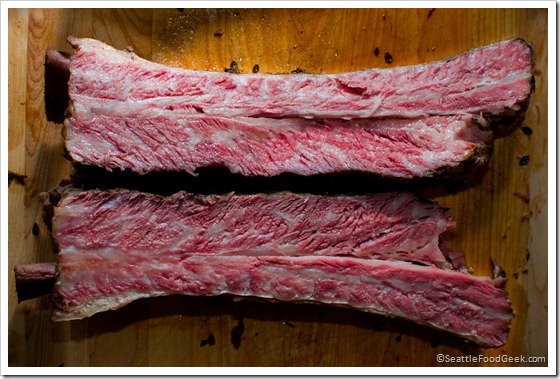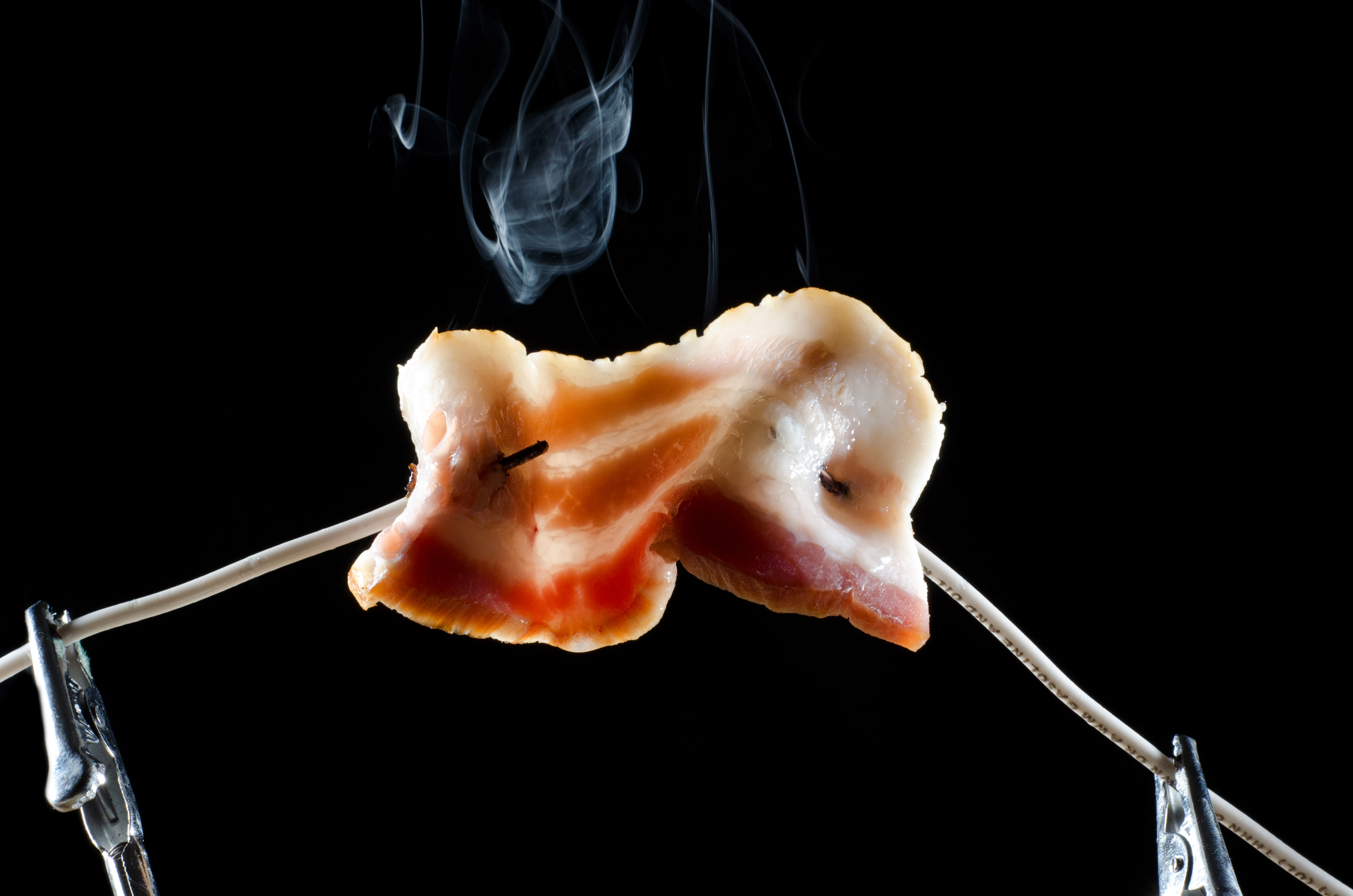
Sous vide cooking works its magic on a lot of foods, but short ribs yield some of the most dramatic results I’ve seen. In traditional recipes, the ribs (usually cut into short 2-3” chunks by the butcher) are braised for several hours. Although the braising method adds great flavor and makes the meat extremely tender, the meat is also necessarily well-done. But, thanks to our sous vide wizardry, we’re able to maintain a perfectly-pink medium rare and have our meat come out fork-tender. Feel free to experiment with marinades in the bag, but know that some herbs, like thyme, will start to reek after 3 days in the bath.
Makes: 6-8 best-of-both-worlds short ribs
Total kitchen time: 72.5 hours (give or take)
Shopping list:
- 6 lbs. short ribs (I used a 6 lb. uncut slab from my butcher, but you can use 6-8 pre-cut pieces)
- 8 cloves garlic, smashed
- 2 tbsp. coarse smoked salt (I prefer Alder wood smoked salt)
Special equipment: sous vide heating immersion circulator, vacuum sealer and (optional) blowtorch.
- Preheat a large water bath to 56C (133F).
- If using an uncut slab of short ribs, trim off any large areas of fat on both sides.
- Coat all sides of the meat with salt and garlic cloves. Place slab (or pre-cut short ribs) into a large vacuum seal bag. If using pre-cut pieces, you may need to divide them between 2 bags, ensuring there is plenty of space between the ribs. Seal the bag.
- Fully submerge your bags in the water bath and cook, turning the bags every 12-18 hours. After 60 hours, increase the heat to 62.5C (144.5F) and cook an additional 12 hours.
- If using a blow torch: Pace a cooling rack on top of a sheet pan or jelly roll. When ready to serve, remove the ribs from the bag and drain.
- If using a slab of ribs, turn the ribs bone-side-up and slice through the meat between the bones lengthwise to separate out each bone. Cut the membrane running the length of the bone and slide the bone loose (it should give easily, with a little encouragement from your knife). Trim any access fat surrounding where the bone used to be. Cut the trimmed meat into portions.
- If using the blowtorch, place a cooling rack above a sheet pan or jelly roll pan. Place each portion of ribs on the cooling rack, allowing plenty of space in between. Pat the ribs dry with paper towels. Using your torch, sear all sides for a few seconds, or until golden brown.
- If you’re not using a blowtorch, give the ribs a quick fire under the broiler or in a little oil on a smoking-hot skillet to brown all sides as quickly as possible.
- Serve immediately.
After tasting these short ribs, I may never cook any type of ribs the same way again. This summer, I plan to lightly smoke a rack of spare ribs, then cook them sous vide for a few days before finishing them back on the grill. I expect pretty incredible results.

I am so dying to try this myself. It looks amazing.
I am curious about one aspect of sous vide meat cooking.
It’s a common technique to pre-sear meats before braising, pan roasting or even when serving banquet style grill meats. This allows the flavor of the sear or grilling to penetrate the meat a bit as it’s cooking.
Everything I’ve seen of sous vide thus far has involved searing the meat after cooking. Is there a reason you couldn’t put a quick sear on ribs like these, a steak or other cuts before going into the immersion circulator?
@Patrick Absolutely. You can pre-sear, post-sear or both. You may find people divided along religious lines about when to sear, much in the same way people have strong feelings about salting steak before or after cooking.
I’ll do some experiments with pre and post searing and write up the results… soon.
I’ve read many posts about pre and post searing.
The vast majority of opinion is that while pre searing doesn’t hurt it doesn’t add much value.
Most proponents of pre searing do so because of a perceived (or real) need to sterilise the outside of their meat.
I have tried both methods and no longer bother with pre searing as post searing is required to get the Maillard effect (whether pre searing has been done or not).
I recently fed some short ribs cooked (off the bone) at 57C for 48 hours to some Sous Vide skeptics. The result was amazing – AND I didn’t sear at all – there was no facility to do that where I was. The ribs were seasoned with salt and pepper before bagging and then cooked. After cooking I dried them off with some kitchen paper and sliced them for the audience to try.
After that there were no skeptics in the room!
Cheers,
Peter.
OMG! That look amazing. I love short ribs…never thought of doing them this way. Looks like heaven!
Hey Scott,
Just curious–what is the reasoning behind the two stages of heat? I’ve tried 72h @ 55C and 48h @ 60C (which I liked better). In both cases, I was surprised that the connective tissue didn’t get very tender. That’s often my favorite part of the short rib in either a standard braise or a straight BBQ.
-Ben
@brhau Honestly, I don’t know that there’s a particular science between the two stages of heat. But, for whatever reason, that’s how I cooked it and it turned out great, so that’s what I wrote down 🙂
I’m surprised your ribs were still tough after 72h @ 55C – these ribs were quite fork-tender, but I was cooking them uncut, so perhaps the bone helped to conduct heat or otherwise influence the texture.
In both cases, the meat itself was fork tender, but the tendon right up against the bone was not. I was also surprised, but perhaps since the collagen in tendon is held together differently than it it is in the muscle itself, it won’t melt under these conditions. That was the only disappointing part for me in an otherwise pretty awesome meal.
I’m trying your technique right now. This is the first real test of the Immersion Circulator and the foodsaver. My only concern is the bag is inflating. I’m not sure I got all the air out of the bag, so I’m unsure if it will be safe to eat? But at 133.1 deg F I should be safe, right?
Thanx
@Archie If you’re using a foodsaver, it should remove enough air that you won’t have to worry about problems. Remember, too, that food safety depends not only on temperature but on time as well. Then long cooking time helps ensure safety.
What is the difference in cooking the short ribs with or without the bone. Any difference in flavor? G
Try cooling them all the way and THEN put them in your smoker. By the time the rib is heated up through it will have a wonderful smokey flavor w/o overcooking.
@granville Some people claim that the bone imparts flavor, but I’m not sure how objectively true that is for this cooking method. I would guess that the flavor difference is negligible, since you aren’t consuming any of the bone’s marrow, as you do when making a stock with bones.
@brhau, I read somewhere that collagen only starts to dissolve above 60o C…Migth be the reason you got hard tendons…
I love the idea of cooking sous vide, and I believe that this works well, but can I just ask: what is the reasoning/explanation of why leaving the meat at such an ideal temperature for growth of bacteria for 72 hours doesnt cause a health concern?
@Patrick there are fundamentally two types of bacteria you need to worry about when cooking sous vide: aerobic and anaerobic bacteria. Aerobic bacteria need oxygen to survive, and they’re the same type of bacteria that you’re trying to kill in traditional cooking. The long cooking times in many sous vide applications is actually great for killing these guys – pasteurization is a function of both time and temperature, so the longer the food cooks sous vide, the more aerobic bacteria die.
The concern with anaerobic bacteria isn’t the long cooking time but the long time that the food spends in a bag without oxygen.
I don’t have a strong enough background in microbiology to give a full explanation, but it is covered at length in Modernist Cuisine.
This is agreat point to bring up. I offer the thoughts above as general inspiration but clearly there are questions like theone you bring up where the most important thing will be working in honest good faith.
Out of interest, did you take the 60 degree figure directly from Modernist Cuisine ? From memory collagen takes a more intense heat to break down, and if that’s correct i was wondering if this affected the final product.
I’ve cooked beef cheeks sous vide at 60 degrees that are far less tender than when braised at 85 degrees, in an aromatic stock. Could the amount of liquid present account for a change in dryness ? I would assume not, but I’m at a loss to explain the difference.
Pingback: Amazing Ribs Sous Vide | Fresh Water
Pingback: Amazing Ribs Sous Vide | My Blog
Pingback: Sous vide cooking: sucking all the sensation out of food preparation?
Pingback: Sous-Vide: Lower, sometimes slower cooking |